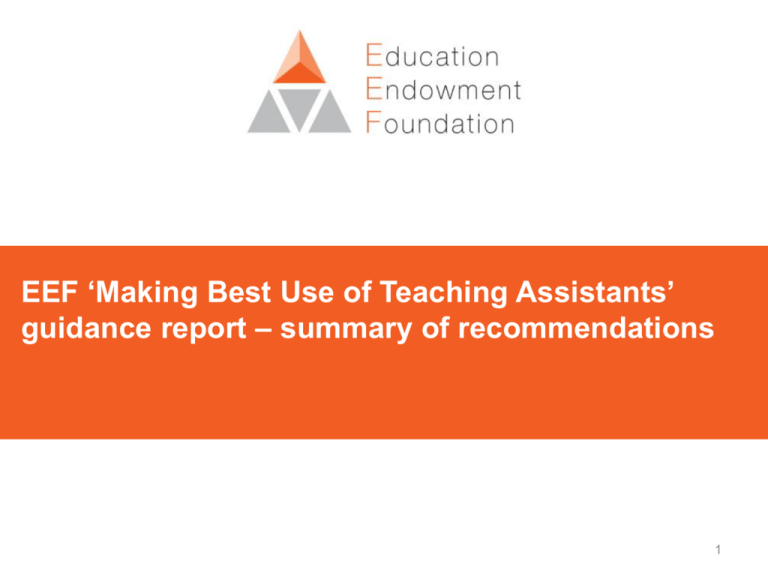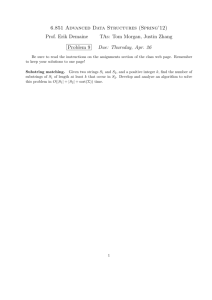EEF 'Making Best Use of Teaching Assistants' guidance report
advertisement

EEF ‘Making Best Use of Teaching Assistants’ guidance report – summary of recommendations 1 The rise and rise of TAs ~250,000 TAs in English schools More TAs than teachers in primary Trebled since 2000 Largest Pupil Premium investment More than roads, housing ~£5bn to employ What an opportunity! ‘Making best use of TAs’ guidance report • Clear and actionable guidance • Digs deeper into EEF evidence (eg Teaching and Learning Toolkit) and relates it to the wider evidencebase • A foundation for scale up actions 7 recommendations on ‘Making best use of TAs’ • Has been drift towards TAs taking on role of ‘primary educator’ for lowattaining/SEN pupils. Well-meaning, but flawed. • Results in greater separation from the classroom, teacher, mainstream teaching/curriculum coverage, and their classmates. Associated with significantly lower learning outcomes. • School leaders must review roles of TAs and teachers. Take a wider view of how TAs can support learning and improve attainment. • High quality teaching, by the teacher, is the foundation for all the recommendations • Schools must break away from discredited ‘Velcro’ model of TA deployment. • If TAs have a direct teaching role, it is important to ensure they supplement rather than replace the teacher. • Teachers need to use TAs more strategically to enable themselves to work more often with lower-attaining/SEN pupils. • Improve the nature and quality of TAs’ talk to pupils to help pupils develop the independent learning skills associated with improved learning outcomes. • Instead of prioritising task completion and correction, TAs should be encouraged to give pupils ‘the least amount of help first’. • TAs’ interactions should help pupils to develop ownership of tasks and to be comfortable to take risks with their learning. Using TAs in the classroom • Lack of opportunities for out-of-class liaison can result in poor teacher-TA collaboration in the classroom. • Schools must provide sufficient time for teachers and TAs to prepare for lessons and for feedback afterwards. • TAs should not ‘go into lessons blind’. Teachers must provide the essential lesson ‘need to knows’ ahead of time. • TAs must be fully trained for roles they are given; for example, in having effective interactions with pupils. • Given the right support and training, TAs can make a significant contribution to pupil attainment delivering 1-2-1/small group interventions (0.2 – 0.3 ES, 3 to 4 additional months progress) . • Positive effects only observed in structured settings, with high-quality support and training. • When TAs deployed in informal, instructional roles they can negatively impact on pupils’ learning (DISS study). Characteristics of effective interventions: • Brief (20-50mins), regular (3-5 times per week) sessions maintained over a sustained period (8-20 weeks). Carefully timetabled • Extensive training from experienced trainers/teachers (5-30hrs) • Structured supporting resources and lesson plans, which are followed closely • Assessments used to identify pupils, guide areas for focus and track progress Examples of evidence-based interventions include Catch Up Numeracy, Catch Up Literacy, Switch-on Reading, Talk for Literacy, Reading Intervention Programme See EEF website for latest evaluation findings and new TA projects Overall use of interventions: • One or two well-chosen, evidencebased interventions, used judiciously to support pupils that are struggling with their learning • At least compensate for time out of class • Don’t assume pupils can make connections with the general curriculum • Supplement ‘quality first’ teaching in the classroom, with clear links made between learning in each context Interventions ‘Health check’ • What does your data show for those pupils involved in intervention work? • Are you using evidence-based interventions? If so, are they being used as intended, with the appropriate guidance and training? • If not, do they reflect the characteristics of effective interventions? • Is appropriate planning provided for timetabling out-of-class sessions so that they complement classroom teaching? • How effective are TAs and teachers reviewing work taking place in intervention sessions? Are pupils supported to make links being made with general classroom work?


